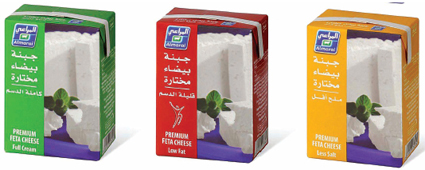
ONE of the most dynamic food & beverage industries in the Middle East is the dairy segment, which is both fairly sophisticated and developed although far from saturated, demonstrating great potential for growth. Dairy products are extremely popular across the Gulf and wider Arab world, and as consumers are increasingly integrating more dairy products in their daily diets, this industry is set to expand. Indeed, dairy products make up an important part of the daily diet, with yoghurt, laban, processed cheese and cream products particularly popular. Dairy consumption in the Middle East is 55kg per person a year (compared to 41kg per capita per year on a global basis), and dairy imports in the region reached $6 billion in 2007 (FAO). The dairy market in the GCC alone is worth $4 billion a year and showing nearly 6 per cent compound annual growth. Consumers in the Gulf States are also the world's biggest cheese eaters. Thriving dairy industries exist in the GCC, led by Saudi Arabia in terms of self-sufficiency and the United Arab Emirates in per capita consumption. Although these countries are building up their herds, they must still rely on dairy imports as raw material for their production. The Saudi dairy industry imports about half of its domestic needs, whilst its Emirati counterpart still imports more than 90 per cent of its milk. New Zealand is a leading supplier of dairy products (powders, proteins, butter and cheeses) to the UAE. Saudi Arabia. The near self-sufficiency in dairy production in Saudi Arabia is quite a feat when one considers how reliant the food and beverage sector as a whole is upon imports. Estimates place Saudi consumption of dairy products at 50kg per capita per year. The main players are Almarai, Al-Safi- Danone, and Saudia Dairy and Foodstuffs Company (SADAFCO), with Almarai and SADFACO also holding strong positions in the GCC dairy markets - in fact, the dairy sector accounts for the majority of its exports to other Gulf countries. Due to the sophistication of Saudi farms, their high production levels and extremely high quality products, many other regional milk producers find it almost impossible to compete with Saudi Arabian producers.

Product diversification: Saudi Arabian food manufacturer and exporter Almarai first launched its white cheese in combiblocSlimline 500ml and combiblocSmall 200ml in 2008 (Photo: SIG Combibloc) United Arab Emirates. The airy processing sector is one of the Emirates' fastest growing industries and one of its most developed. Per capita consumption of dairy products is high, around 80-85kg annually, and accordingly this profitable sector is extremely vibrant and competitive, with many dairies in operation including Al Rawabi, Al Ain, and Marmum Dairy. The total Dairy and Fruit Juices Industry is expanding at a rate of 10 per cent annually, according to a 2009 study by the Department of Economic Development (DED). Despite this healthy growth, however, the DED reports that current production levels meet just 56 per cent of the demand in the UAE. Outside the Gulf Algeria is the largest dairy consumer in North Africa, with 110 litres per capita for milk and 6 kilograms per capita per year for other dairy products. The Algerian dairy sector relies mainly on imports of milk powder and other dairy ingredients to fulfil 80 per cent of the industry requirements. State-owned group Giplait remains the market leader in the pasteurised reconstituted milk, which is are price-controlled, and private sector processors are mainly focused on producing other more profitable processed dairy products than milk. Kuwait possesses a well-developed dairy industry that leverages off the spending power of the population, notes Business Monitor International, and a wide consumption of dairy products - estimated at more than 50kg per capita annually. Leading industr
Adidas NMD R1 ONE of the most dynamic food & beverage industries in the Middle East is the dairy segment, which is both fairly sophisticated and developed although far from saturated, demonstrating great potential for growth. Dairy products are extremely popular across the Gulf and wider Arab world, and as consumers are increasingly integrating more dairy products in their daily diets, this industry is set to expand. Indeed, dairy products make up an important part of the daily diet, with yoghurt, laban, processed cheese and cream products particularly popular. Dairy consumption in the Middle East is 55kg per person a year (compared to 41kg per capita per year on a global basis), and dairy imports in the region reached $6 billion in 2007 (FAO). The dairy market in the GCC alone is worth $4 billion a year and showing nearly 6 per cent compound annual growth. Consumers in the Gulf States are also the world's biggest cheese eaters. Thriving dairy industries exist in the GCC, led by Saudi Arabia in terms of self-sufficiency and the United Arab Emirates in per capita consumption. Although these countries are building up their herds, they must still rely on dairy imports as raw material for their production. The Saudi dairy industry imports about half of its domestic needs, whilst its Emirati counterpart still imports more than 90 per cent of its milk. New Zealand is a leading supplier of dairy products (powders, proteins, butter and cheeses) to the UAE. Saudi Arabia. The near self-sufficiency in dairy production in Saudi Arabia is quite a feat when one considers how reliant the food and beverage sector as a whole is upon imports. Estimates place Saudi consumption of dairy products at 50kg per capita per year. The main players are Almarai, Al-Safi- Danone, and Saudia Dairy and Foodstuffs Company (SADAFCO), with Almarai and SADFACO also holding strong positions in the GCC dairy markets - in fact, the dairy sector accounts for the majority of its exports to other Gulf countries. Due to the sophistication of Saudi farms, their high production levels and extremely high quality products, many other regional milk producers find it almost impossible to compete with Saudi Arabian producers.
ONE of the most dynamic food & beverage industries in the Middle East is the dairy segment, which is both fairly sophisticated and developed although far from saturated, demonstrating great potential for growth. Dairy products are extremely popular across the Gulf and wider Arab world, and as consumers are increasingly integrating more dairy products in their daily diets, this industry is set to expand. Indeed, dairy products make up an important part of the daily diet, with yoghurt, laban, processed cheese and cream products particularly popular. Dairy consumption in the Middle East is 55kg per person a year (compared to 41kg per capita per year on a global basis), and dairy imports in the region reached $6 billion in 2007 (FAO). The dairy market in the GCC alone is worth $4 billion a year and showing nearly 6 per cent compound annual growth. Consumers in the Gulf States are also the world's biggest cheese eaters. Thriving dairy industries exist in the GCC, led by Saudi Arabia in terms of self-sufficiency and the United Arab Emirates in per capita consumption. Although these countries are building up their herds, they must still rely on dairy imports as raw material for their production. The Saudi dairy industry imports about half of its domestic needs, whilst its Emirati counterpart still imports more than 90 per cent of its milk. New Zealand is a leading supplier of dairy products (powders, proteins, butter and cheeses) to the UAE. Saudi Arabia. The near self-sufficiency in dairy production in Saudi Arabia is quite a feat when one considers how reliant the food and beverage sector as a whole is upon imports. Estimates place Saudi consumption of dairy products at 50kg per capita per year. The main players are Almarai, Al-Safi- Danone, and Saudia Dairy and Foodstuffs Company (SADAFCO), with Almarai and SADFACO also holding strong positions in the GCC dairy markets - in fact, the dairy sector accounts for the majority of its exports to other Gulf countries. Due to the sophistication of Saudi farms, their high production levels and extremely high quality products, many other regional milk producers find it almost impossible to compete with Saudi Arabian producers.  Product diversification: Saudi Arabian food manufacturer and exporter Almarai first launched its white cheese in combiblocSlimline 500ml and combiblocSmall 200ml in 2008 (Photo: SIG Combibloc) United Arab Emirates. The airy processing sector is one of the Emirates' fastest growing industries and one of its most developed. Per capita consumption of dairy products is high, around 80-85kg annually, and accordingly this profitable sector is extremely vibrant and competitive, with many dairies in operation including Al Rawabi, Al Ain, and Marmum Dairy. The total Dairy and Fruit Juices Industry is expanding at a rate of 10 per cent annually, according to a 2009 study by the Department of Economic Development (DED). Despite this healthy growth, however, the DED reports that current production levels meet just 56 per cent of the demand in the UAE. Outside the Gulf Algeria is the largest dairy consumer in North Africa, with 110 litres per capita for milk and 6 kilograms per capita per year for other dairy products. The Algerian dairy sector relies mainly on imports of milk powder and other dairy ingredients to fulfil 80 per cent of the industry requirements. State-owned group Giplait remains the market leader in the pasteurised reconstituted milk, which is are price-controlled, and private sector processors are mainly focused on producing other more profitable processed dairy products than milk. Kuwait possesses a well-developed dairy industry that leverages off the spending power of the population, notes Business Monitor International, and a wide consumption of dairy products - estimated at more than 50kg per capita annually. Leading industrAdidas NMD R1
Product diversification: Saudi Arabian food manufacturer and exporter Almarai first launched its white cheese in combiblocSlimline 500ml and combiblocSmall 200ml in 2008 (Photo: SIG Combibloc) United Arab Emirates. The airy processing sector is one of the Emirates' fastest growing industries and one of its most developed. Per capita consumption of dairy products is high, around 80-85kg annually, and accordingly this profitable sector is extremely vibrant and competitive, with many dairies in operation including Al Rawabi, Al Ain, and Marmum Dairy. The total Dairy and Fruit Juices Industry is expanding at a rate of 10 per cent annually, according to a 2009 study by the Department of Economic Development (DED). Despite this healthy growth, however, the DED reports that current production levels meet just 56 per cent of the demand in the UAE. Outside the Gulf Algeria is the largest dairy consumer in North Africa, with 110 litres per capita for milk and 6 kilograms per capita per year for other dairy products. The Algerian dairy sector relies mainly on imports of milk powder and other dairy ingredients to fulfil 80 per cent of the industry requirements. State-owned group Giplait remains the market leader in the pasteurised reconstituted milk, which is are price-controlled, and private sector processors are mainly focused on producing other more profitable processed dairy products than milk. Kuwait possesses a well-developed dairy industry that leverages off the spending power of the population, notes Business Monitor International, and a wide consumption of dairy products - estimated at more than 50kg per capita annually. Leading industrAdidas NMD R1
 iConnectHub
iConnectHub
 Login/Register
Login/Register Supplier Login
Supplier Login



























